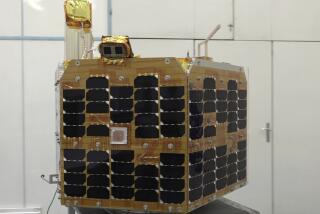Winged Rocket Pares Cost of Lofting Payload
- Share via
EDWARDS AIR FORCE BASE — In what was billed as a preview of high-tech, low-cost space flight, a satellite-deploying rocket that will be launched from the belly of a B-52 bomber was unveiled here Thursday.
The Pegasus Air-Launched Space Booster is designed to deliver small to medium-sized payloads into orbit around the Earth at a cost two to three times less than that offered by current launch systems.
Sporting a 22-foot delta wing, Pegasus combines new technology with previous Navy and Air Force missile designs, explained Pegasus chief engineer Antonio Elias. Elias designed the rocket for the Virginia-based Orbital Sciences Corp.
In addition to the delta wing and an array of navigational microelectronics, the 50-foot-long, non-reusable Pegasus uses lightweight graphite composite materials for most of its body.
“Because we use an airplane as our first (rocket) stage, we don’t have to incur the expense of a throw-away first stage or of a launch pad that would require substantial refurbishment after each launch,” Orbital Sciences President David Thompson said.
Although its first flight will deploy a Defense Advanced Research Projects Agency satellite to help track Soviet submarines for the military, company officials predict that Pegasus’ low cost will allow smaller countries, states and even universities the opportunity to orbit satellites and to participate in space experiments.
“At $6 million per launch, we’ve lowered the threshold for customers to get into space,” said Orbital Sciences spokeswoman Barbara Zadina. Zadina and others cited the cost of between $30 million and $100 million normally charged by NASA for satellite deployment as a limiting factor for many potential space players.
Orbital Sciences is particularly interested in tapping the European market and has signed an agreement with Arianespace, based in France, to sell Pegasus internationally.
Doug Heyden, president of Arianespace USA, a division of Arianespace Europe, said the market for Pegasus overseas should develop now that the technology exists. “People will develop payloads to do certain specific missions that will use the Pegasus capability,” Heyden said.
Pegasus’ maiden flight is scheduled for October when it will be launched over the Pacific Ocean near the California coast. Five seconds after being released from the underside of a NASA B-52 at an altitude of about 40,000 feet, the first of Pegasus’ three solid-fuel engines will thrust the rocket to a speed of Mach 8, or eight times the speed of sound, and using the delta wing for lift, carry it to an altitude of 200,000 feet before disengaging. From there the second and third-stage engines will take the craft to higher altitudes before releasing its orbital payload at the desired point.
In addition to the military satellite, Pegasus on its first flight is scheduled to deploy two canisters of barium gas as part of a NASA experiment to study Earth’s magnetic field. Originally slated to be carried aboard a NASA LTV Scout booster, the experiment is expected to cost $10 million less aboard Pegasus, according to the trade publication Aviation Week and Space Technology.
An environmental satellite for the state of Virginia has also been tentatively scheduled aboard the first flight, Orbital Sciences’ Zadina said. However, she said, those negotiations are still under way.
More to Read
Sign up for Essential California
The most important California stories and recommendations in your inbox every morning.
You may occasionally receive promotional content from the Los Angeles Times.










